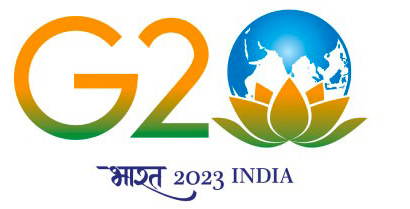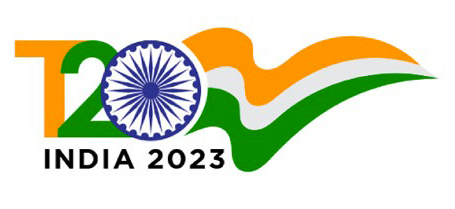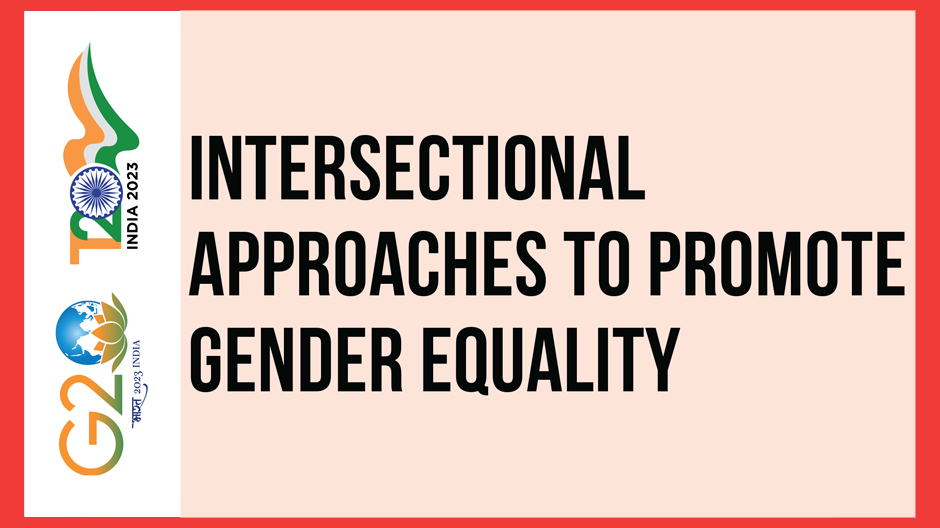Task Force 6: Accelerating SDGs—Exploring New Pathways to the 2030 Agenda
Striving for gender equality and empowerment has been the focus of the G20 and its 2030 agenda. The impact of various historical, social, economic, and geographical factors have led to women being marginalised and excluded from the development process. Recognising the intersectionality of women’s vulnerability is critical to break them out from the cycle of systemic gender injustices. Learning from diverse experiences of how intersectionality compounds the vulnerability of women is necessary for designing policies that can contribute to a more inclusive economy. This policy brief underscores the need for the G20 to adopt an intersectional approach in its discussions on sustainable and inclusive development to fulfil its agenda of gender equality and empowerment in a substantial manner.
1. The Challenge
Women-led development has been identified as a central theme of the G20 India presidency. Despite the global momentum to address existing gender gaps in labour force participation, equal pay as well as discrimination and gender stereotypes, there is limited recognition of complex gender relations and the role of power and positions, especially around the issues of intersectional identities within gender. The origin of intersectionality can be traced to feminist theories and is used to understand the complex and interconnected nature of social identities and how they interact leading to unique experiences of discrimination, oppression and privilege. Within gender, intersectionality acknowledges that individuals do not experience gender in isolation; it interacts with other dimensions of their identity such as age, race, ethnicity, socioeconomic background and religion.[1] Intersectionality works in association with positionality, which reflects an individual’s social standing within cultures, social structures and power hierarchies.[2]
Gender, socioeconomic status, ethnicity, nationality, age, location, caste and norms have a bearing on the impacts, vulnerability, responsibility and decision-making abilities of individuals and groups. A more holistic approach would consider how separate categories, such as race, class, gender and sexuality, relate with each other to produce the dynamic identity of an individual, beyond their respective categorisations. For instance, evidence indicates that in areas affected by climate change and environmental crisis, the practice of child marriage is common among lower-income households with a limited resource base.[3] Likewise, in the case of sexual and gender-based violence, such interlinkages may also act as barriers in reporting these incidents as well as accessing support, resources and assistance by the survivors. Assessing the impact of sustainable development goals on women through an intersectional lens also reveals how different forms of inequality operate in conjunction, exacerbating one another. It is well known that risks are higher especially for women belonging to indigenous communities, marginalised populations, ethnic minorities and women with disabilities.[4]
Intersectionality is best illustrated through the Joint Forest Management (JFM) scheme, which is a product of enhanced participation initiatives by the Government of India. This scheme involves a partnership between the local people and the forest department for the management of natural forests. The JFM policy in India remained a local and de-politicised issue and related to an undifferentiated category called “women”. Reports also illustrate the need to enhance the scope for participation in the scheme, which was a deliberate attempt from the policy formulation stage. Elias, Grosse and Campbell in their article illustrated this issue of gender inclusion by taking two cases from the states of Karnataka and Madhya Pradesh.[5] The study highlighted that the lack of women’s participation in the JFM policy is a three-fold issue. Firstly, women’s labour constraints, primarily caused due to household chores, limit their ability to devote extra time and effort to plantation-based activities. Secondly, conflict of interest with the forest department regarding procurement of fuel woods has discouraged women from working with them. Lastly, women who do not engage in forestry activities simply lack interest in contributing to the sector. Moreover, several studies have also highlighted the significance of understanding the role of gender in shaping exclusion within the JFM policy. This needs to be understood in relation to caste or ethnicity, as these factors have an intrinsic relationship with landholdings, education and class. In other words, unless intersecting axes of social differentiation and marginalisation of women in relation to forests, the state, different group of men and each other are accounted for, the idea of inclusive forest governance will always be loose.
Similar gaps in the identification of intersectional dimensions can be observed in welfare schemes targeted at women. A common measure of mapping the performance of interventions and schemes usually involves tracking the enrolment of beneficiaries without mapping of inactive or dormant beneficiary accounts. A one-size-fits-all approach adopted in policy design across sectors fails to draw linkage inherent to one’s identity, position and historical, political and geographic dimensions thereby reinforcing existing gender stereotypes. In several cases, the initial costs of enrolment and the first set of benefits are covered by the government whereas the subsequent costs need to be borne by the beneficiaries. The policy design in schemes overlooks and fails to establish linkages with income-generating activities. Additionally, policies targeted at women’s empowerment do not account for the limited agency and decision-making power of women.[6] Existing approaches also inadequately account for the time spent by women on domestic chores and care-giving activities, despite evidence that illustrates how the time spent on performing these household tasks not only varies by gender but also differs by location (rural vs urban and across states), education status, marital status, employment status as well as existing social norms on decision making and ownership of land.[7]
2. The G20’s Role
The unique structure of the G20 with its different working and engagement groups provides the perfect platform to introduce a new model of informed intersectional policy design. Through its various groups, the G20 has already conducted research on how to reduce racial discrimination, enhance access to and quality of education, and promote gender equality. As these working groups bring together the experts of such interconnected fields of study together on a regular periodic basis, the G20 process can be further devoted into an iterative cycle of enhancing intersectional policy making. Furthermore, within the unique architecture of the G20, the Women20 (W20) engagement group is already focussed on supporting gender-inclusive economic growth. With support of Civil20 (C20), a joint statement was signed on gender equality, with recommendations to advance women’s economic empowerment and their integration into the global economy.[8] Under Indonesia’s chairmanship, the G20 Conference on Women’s Empowerment identified areas requiring significant investment, namely high-quality, inclusive, and affordable care facilities; digital technology; and infrastructure and tools for micro, small and medium enterprises (MSMEs). Recommendations also included the development of sex-disaggregated databases and domestic policies. To sustain the momentum of work on women-centric issues, the 2023 India Presidency have identified five priority areas. These include women’s entrepreneurship, women’s leadership at the grass roots level, bridging the digital divide, education and skill development, and climate change.
The G20 platform also provides an opportunity to focus on global issues around gender and fill the gaps among the commitments of its member countries regarding the intersectionality on issues such as sexual and gender-based violence (SGVB). For example, from 2017 to 2018, the G20 announced its commitment to combat gender-based violence. To address the issue of violence, more than half of the G20 countries have legislations in place to address violence against women, and all G20 countries—except for Russia—have mechanisms that target domestic violence. Seventeen of the G20 countries also have legal frameworks that explicitly offer protection from sexual harassment. However, the Organisation for Economic Co-operation and Development (OECD) in its report points out that despite these efforts, there is an “absence of laws in G20 countries that offer protection to all women and girls from any and all existing forms of gender-based violence including domestic violence and sexual harassment in all spheres of life.”[9]
Lastly, finance would play a critical role in ensuring the implementation of gender-just and intersectional policies and interventions, as well as the piloting of such structures within nations and other multilateral bodies. However, there is a critical gap in the requirements and monitoring of intersectional gender-positive impacts in the policies of several multilateral funds, including the Bretton Woods institution (BWI). These stem from the lack of well-defined intersectional indicators to mark progress, as well as a lack of representation of women, especially from the global south in the decision-making committees of such bodies. The ability of multilateral funds to realise the implications of their gender-mainstreaming activities is still constrained by bureaucratic issues. As a result, a significant share of finance from multilateral organisations remains inaccessible to local women’s organisations who do not possess the ability to apply for and manage these grants.[10] Through its position in the global financial landscape, the G20 is uniquely positioned to act as a regulator to ensure that the criterion for transformative and intersectional gender action is undertaken as part of the international funding arrangements. The agenda for the Indian G20 presidency is also expected to largely focus on the issue of reforms within multilateral development banks (MDBs) and the Bretton Woods institutions (BWI), which can be an opportunity for the setting up of gender-positive decision-making structures within these institutions.
3. Recommendations to the G20
There is a need to incorporate an intersectional approach into the design of policies, which goes beyond categorisations to understand the nature of positional identities of individuals through their gender, race, sexual orientation, economic status, education, and other such socioeconomic realities. Such a process would entail the involvement of policymakers and advisory groups across the education sectors, women protection and empowerment, finance, and law and others, so that a holistic, inclusive, and intersectional approach can be followed in policy design. Therefore, we recommend the setting up of a formal working group for intersectional policy design within the G20 architecture that constitutes a group which draws on the expertise of the G20 group to design intersectional policies and ensures women empowerment and inclusivity throughout the workings of the G20. With its unique structure of working groups and engagement groups, the G20 already carries out a deliberative process across many of these socioeconomic criteria, especially by taking action to promote gender equality, prevent racism, undertake economic development, and enhance education access and quality. The G20 can easily leverage this existing model of collaborative deliberation to introduce a formal policy working group, which can incorporate the inputs of the different work streams for the design and creation of policies and interventions of a truly intersectional and multidimensional nature.
Furthermore, the policy brief identifies three initial focus areas for the working group built around the themes of gender-just development finance, enhanced participation of women in workforce, and the elimination of SGBV. This working group would be well positioned to leverage the unique experiences of such intersectional identities across a variety of backgrounds and cultures and synthesise the learnings of the various experts within several G20 workstreams. The proposed inclusive and intersectional working group can inform much more cohesive and impactful policymaking, as well as reiterating improvements every year on a periodic basis to ensure the ongoing effectiveness of these policies. The recommended initial focus areas of this group are highlighted the following sections, which can be further expanded on an annually iterative basis.
Launch a leader’s initiative on women’s workforce development
The policy working group can encourage the G20 to call upon multiple engagement groups to form a leader’s initiative on women’s workforce development. These initiatives can increase opportunities for young girls and women in low- and middle-income countries to access gainful employment. They can also facilitate apprenticeships, internships and mentorships that enable women to enhance their skillsets and improve market access for female entrepreneurs. Improving workforce participation of women across sectors through such schemes may further translate into advanced educational opportunities and health benefits, eventually enabling women to improve their positionality. It may further result in improved prospects for more women across similar intersectional identities to access these initiatives for growth and development.
Gender-focused financial monitoring
The policy working group can serve as a monitoring agency to unify gender-reporting markers to prevent mismarking and misreporting across scales and projects. The policy can lead the formulation of a gender index like the Bloomberg Gender Equality Index or the OECD development assistance committee (DAC) gender marker, which may be used to assess the gender implications of finance and track performance of both public and private entities towards gender-inclusive action. These indices should also be further developed to encompass various aspects of intersectional identity and positionality that need attention through finance, contributing to the socioeconomic development of women across the strata of these identities.
Furthermore, the G20 can leverage its influence to ensure that such intersectional gender markers are inherently integrated in emerging decisions and processes such as the Loss and Damage Fund established for vulnerable communities at COP27. These markers would guarantee that a gender-just finance is governed by the ideas of recognition, representation, redistribution, transparency and accountability across the various strata of intersectional identities of gender.
Gender-based financial instruments and reform
This working group can be a key part of the finance track of the G20, especially in the meetings of the G20 Finance Ministers and Central Bank Governors (FMCBG). The establishment of a gender financing working group within the finance track of the G20 would empower the G20 to take the lead in developing an international agenda of gender budgeting. This initiative would also involve creating gender markers to ensure that finance is directed towards achieving improved socioeconomic outcomes for women. Such a working group can also ensure that issues of gender and finance are reflected in the other initiatives of the G20.
Furthermore, the MDB and BWI reform agenda of the G20 provides a unique opportunity for the representational and funding frameworks of these organisations to involve a greater degree of intersectional identities. This can be achieved by enhancing the representation of women, especially from the global south, within the decision-making bodies of these organisations. Such a reform can also ensure that the funding mechanisms of the BWI supports a framework of ex-ante gender and human rights impacts from interventions and policies.
Condemnation of sexual and gender-based violence
Despite gender-based violence being a core area of work for the G20, it is yet to endorse mechanisms to end all forms of violence in all its contexts through the adoption of a comprehensive approach. The working group can promote a practice of enlisting, highlighting and condemning all instances of SGVB at the annual G20 conference, especially those in conflict and disaster-affected regions. The no-tolerance policy against SGVB must be echoed across all working groups and all existing mechanisms must be expanded to include all women and girls and offer protection from all forms of gender-based violence in all spheres of life.[11] The working group should also encourage the G20 to push for fast-tracking processes as well as the establishment of counselling centres and other facilities. In the context of climate change, the G20 should push for the collection of disaggregated data based on age, race, ethnicity, socioeconomic status, indigenous groups and other contextually relevant identities to understand how intersecting identities impact the experience of violence in the aftermath of disasters. There should be focus on expansion of existing communications and campaigns on SGBV in collaboration with international organisations, donors, women’s rights organisations as well as ministries backed by the G20. The working group can also advocate for the G20 to utilise its influence across international platforms, urging for the ratification of international conventions on women’s rights. This effort would aim to create a global consensus, acknowledging, protecting, and expanding gender rights worldwide. Such a structure must integrate SGBV into the agenda of institutional and MDB reform to mobilise finance and further support. The World Bank has adopted some initiatives for integrating SGBV into their strategies and policies through implementing shock responsive safety nets. However, this also needs to be part of the core reform agenda for other MDBs to address this issue by mobilising multilateral funds for mitigating SGBV.
Attribution: Smita Chakravarty, Amlan Mishra, and Soham Banerjee, “Intersectional Approaches to Promote Gender Equality,” T20 Policy Brief, August 2023.
[1] Weldon, S. Laurel, “Intersectionality” Politics, Gender and Concepts: Theory and Methodology (2008): 193–218; Shields, Stephanie A, “Gender: An Intersectionality Perspective,” Sex Roles 59 (2008): 301–311.
[2] Yep, Gust A, “Toward the De-subjugation of Racially Marked Knowledges in Communication,” Southern Communication Journal 75, no. 2 (2010): 171–175.
[3] “How Climate Change is Driving Child Marriages,” End Violence Against Children, Accessed July 26, 2023.
[4] “Intersectional Feminism: What It Means and Why It Matters Right Now,” UN Women, Accessed July 26, 2023.
[5] Elias, Marlène, Alessandra Grosse and Natalie Campbell, “Unpacking ‘Gender’ in Joint Forest Management: Lessons from Two Indian States,” Geoforum 111 (2020): 218–228.
[6] Michael, Kavya, Manish Kumar Shrivastava, Arunima Hakhu, and Kavya Bajaj, “A Two-step Approach to Integrating Gender Justice into Mitigation Policy: Examples from India,” Climate Policy 20, no. 7 (2020): 800–814.
[7] Nikore, Mitali, “Building India Economy on the Backs of Women Unpaid Work: A Gendered Analysis of Time-Use Data,” (2022).
[8] Larionova, Marina, Mark Rakhmangulov, Elizaveta Safonkina, Andrei Sakharov, and Andrey Shelepov, “G20 Priorities and Decisions under Turkey’s 2015 Presidency: Implementation, Inclusiveness and Investment for Strong, Sustainable and Balanced Growth,” International Organisations Research Journal 12, no. 1 (2017): 148–73.
[9] Organisation for Economic Co-operation and Development (OECD), Ending Gender-based Discrimination in G20 Countries: A Frame for Action, 2021, Organisation for Economic Co-operation and Development (OECD), 2021.
[10] Huang Jenny, “Equal Opportunity to Adapt: Improving Gender-Responsive Access to Climate Adaptation Financing,” (Master diss., Harvard Kennedy School, 2022).





